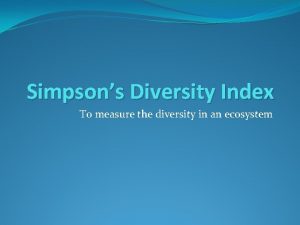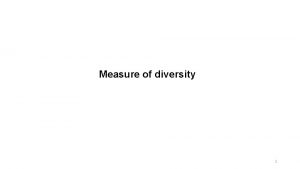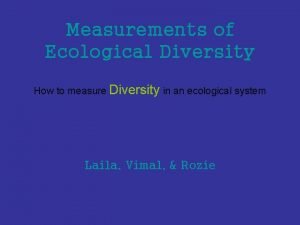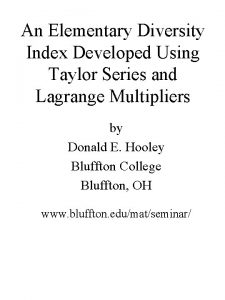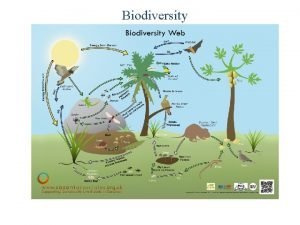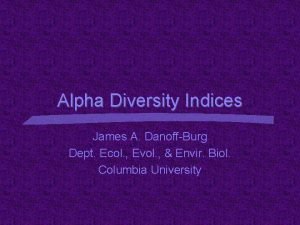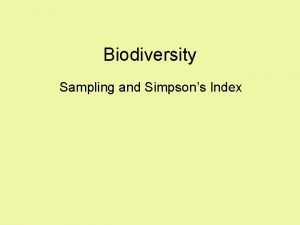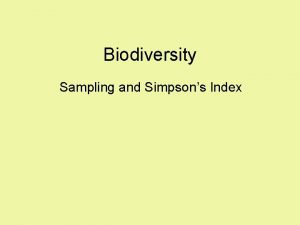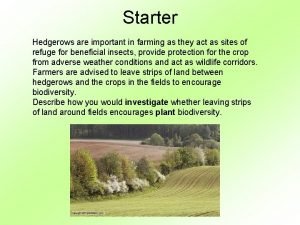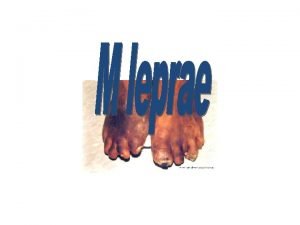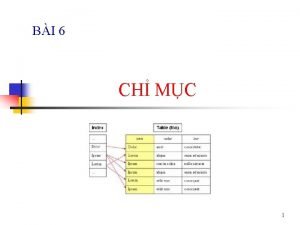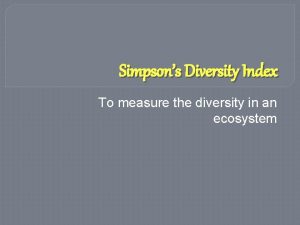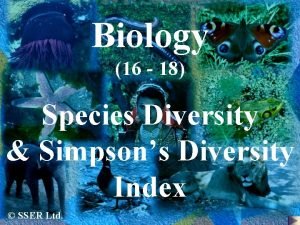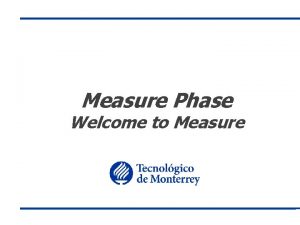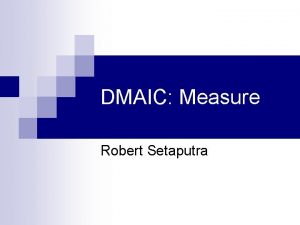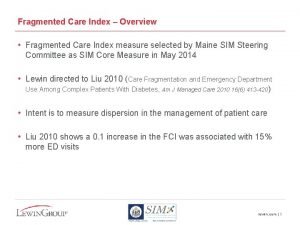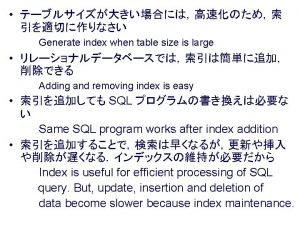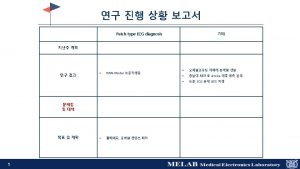Simpsons Diversity Index To measure the diversity in



















- Slides: 19

Simpson’s Diversity Index To measure the diversity in an ecosystem

Simpson’s Diversity Index �Attempts to quantify the diversity (variety) of an ecosystem. �There are two components: Evenness Richness

Evenness �Evenness is a measure of the relative abundance of the different species within an area. (Same amount of each kind of organism) �When the numbers of each type of species is even, the value for the Simpson Diversity Index will be larger.

Richness = variety �Richness is a measure of the number of kinds of species �More species is “richer” so the value for the index will be higher.

High Richness Native Valdivian Temperate Rainforest

Low richness (Pinus Radiata forest)

The equation D = N(N - 1) n(n -1) D = diversity index N = total number of organisms of all species found n = number of individuals of a particular species

How to Calculate D: D = N(N – 1) n(n -1) 1. 2. 3. 4. Record the numbers of each species Calculate n-1 for each species Find the total number of organisms, N Calculate the Simpson Diversity Index

Let’s Try an Example � You have studied a specific site, and have counted the individuals of five different species. � n is the total number of organisms of a particular species. Species A 12 Species B 3 Species C 7 Species D 4 Species E 9 Page 11 Teacher Zone n nature. ca/education

Simpson’s Index D = n n - 1 n(n - 1) ∑ n(n - 1) Species A 12 11 132 N(N - 1) Species B 3 2 6 Species C 7 6 42 Species D 4 3 12 Species E 9 8 72 ∑ n(n - 1) = 264 ∑ n(n - 1) Page 12 Teacher Zone nature. ca/education 264

Simpson’s Index D = ∑ n(n - 1) = N(N - 1) 264 N(N - 1) N = total number of all individuals = 35 N - 1 = 34 N(N - 1) = 1190 D = 264 1190 = 0. 22184 This area would score 0. 22184 on the Simpson’s Index. The scale ranges from 0– 1, with 1 representing the lowest biodiversity. Therefore, the score for this area indicates a high level of biodiversity. Page 13 Teacher Zone nature. ca/education

Calculate the Simpson’s Diversity Index for each sample Compare the evenness and richness of each sample.

Answers �Sample One: 2. 99 �Sample Two: 1. 15 �Both have the same richness as there are three species in each area. �Sample One is more even because the numbers of each kind of species are nearly the same.

A high value of D suggests a stable, complex and diverse ecosystem.

A low value of D could suggest pollution, recent colonization or agricultural management. Eukalyptus plantation Deforestation in Chile

The lowest value of D is 1. 0 (monoculture)

Compare Simpson’s Diversity Index for a tropical rainforest vs a desert

Biodiversity at Sites in Honduras The following calculations are based on sampling conducted in Honduras by Canadian Museum of Nature research scientist Bob Anderson. Site N N(N - 1) D Species Richness 2996 7 120 892 1 600 002 0. 2247 61 El Pital 2050 m 233 54 056 6856 0. 1268 22 El Pital 2650 m 5411 29 273 510 12 873 694 0. 4398 46 Cerro Puca 311 96 410 19 126 0. 1984 27 Santa Barbara 839 703 082 55 514 0. 0789 44 Cerro Montecristo ∑ n(n - 1) Page 14 Teacher Zone nature. ca/education

Biodiversity at Sites in Honduras � Which site has the highest species richness? � Which site is the most diverse according to the Simpson’s Index? (HINT: Has the lowest D). � Do any sites have both a low Simpson’s Index and high species richness? Which one(s)? Page 15 Teacher Zone nature. ca/education
 Simpson's diversity index
Simpson's diversity index Shannon index
Shannon index Is measure for measure a comedy
Is measure for measure a comedy Uses of wind vane
Uses of wind vane Alpha beta and gamma diversity
Alpha beta and gamma diversity Why is genetic diversity important
Why is genetic diversity important Genetic diversity vs species diversity
Genetic diversity vs species diversity Elementary taylor series
Elementary taylor series Species evenness formula
Species evenness formula Alpha diversity index
Alpha diversity index Simpson's diversity index formula
Simpson's diversity index formula Exotic species definition
Exotic species definition Simpson's diversity index formula
Simpson's diversity index formula Simpson's diversity index formula
Simpson's diversity index formula Liquid limit of soil formula
Liquid limit of soil formula Leprosy
Leprosy Clustered index và non clustered index
Clustered index và non clustered index Compare india and sri lanka on the basis of hdi
Compare india and sri lanka on the basis of hdi Mode theory of circular waveguide
Mode theory of circular waveguide Primary index is dense or sparse
Primary index is dense or sparse
